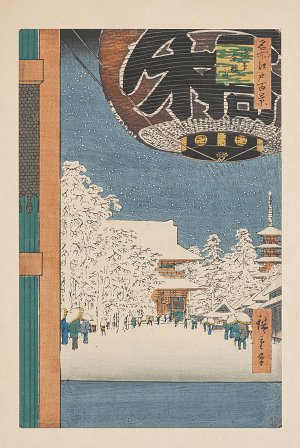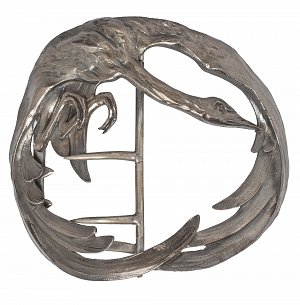
Hiroshige Utagawa, “Kinryuzan Temple at Asakusa” From the series “One hundred famous views of Edo” Print Japan, 1856
Musée des Arts Décoratifs
© MAD Paris / photo Jean Tholance
Since its founding in 1864, the Musée des Arts Décoratifs has been at the forefront of preserving and presenting Japanese art in France. With the opening of Japanese borders to the West in 1868 at the beginning of the Meiji Period,
a sweeping dialogue between East and West began. In 1869, the Musée des Arts Décoratifs organized the first major exhibition of Eastern art in France with a concentration on Japan. The museum has since acquired, preserved and displayed remarkable examples of Japanese decorative arts.
“Japon-Japonismes, 1867-2018” will present the Musée de Arts Décoratifs’
collection of historic Japanese artworks – one of the most important in France –
alongside Western Japanized creations. Works of art have also been loaned by
cultural institutions, private collections and artists from Japan, reinforcing the
notable level of interest in the exhibition. Artists will include Hokusai, Emile Gallé,
René Lalique, Kuramata Shiro, Charlotte Perriand and Tanaka Ikkō. Furthermore,
the works of seven French participants of the “Wonder Lab” exhibition held at the
Tokyo National Museum in 2017, counting Jean Girel, Michel Heurtault, Sylvain Le
Guen, Laurent Nogues, François-Xavier Richard, Pietro Seminelli and Nelly Saunier
will be displayed.

Charles Boutet de Monvel, “Crane” Belt buckle France, 1900-1903
Musée des Arts Décoratifs
© MAD Paris / photo Jean Tholance
Visitors will have the opportunity to admire nearly 1,500 works of art spanning a wide variety of artistic media, including art and design, fashion, graphic arts and photography. Sou Fujimoto, acclaimed Japanese minimalist architect, well known for his Serpentine Gallery Pavilion 2013 in London and the Musashino Art University Museum and Library in Tokyo, is responsible for the exhibition design, which extends over 2,200 m2 on three floors of the Rohan Wing. Fujimoto’s design will focus on five themes: Agents of Discovery, Nature, Time, Movement and Innovation.
“Agents of Discovery,” the first of the exhibition’s five themes, begins with
collections brought from Japan by travellers and merchants the likes of Henri
Cernuschi, Émile Guimet, Hugues Krafft, Siegfried Bing, Florine Langweil and
Hayashi Tadamasa. These individuals not only facilitated the dissemination of
Japanese objects in Europe including lacquerware, ceramics, prints, bronzes,
baskets, combs, textiles, wallpapers, katagami, kimono and tsuba, but
also introduced Western designs to the Japanese. Western attraction to
Japanese artistic techniques, principally the composition of Japanese prints, the
refinement of their porcelain, ceramics and metalwork and the delicacy of
their lacquer, spurred European artistic production resulting in a style ever-more
referred to as Japanism.

Charlotte Perriand, Bamboo chaise longue Japan, 1940
Musée des Arts Décoratifs
© MAD Paris / Jean Tholance Adagp, Paris, 2018
“Nature”, a source of inspiration important to Japanese and Western artists, plunges
the visitor into a world of plants, flowers and animals. Motifs inspired by flora
and fauna opened up an ornamental and symbolic lexical field in 1868 that
contributed to the foundations of Japanism both in France and around the
world.
“Time”, and the relationships that the Japanese maintain with their own history,
is illustrated through the rhythm of the seasons and the traditional life in the Edo
period (1603-1868). Subjects relating to daily life and customs such as the
ceremonies surrounding tea, incense and calligraphy, as well as those linked to
spirituality, invite the visitor to witness the Japanese reverence for time and history.

Sato Oki, “Cabbage” Chair, Nendo Editions Japan, 2008
Musée des Arts Décoratifs
© MAD Paris / photo Jean Tholance
In addressing the theme of “Movement”, the exhibition underscores the capacity of Japanese artists to seize the present moment on paper – a capacity that European artists have emulated. Movement is also expressed in the lines of certain historic and contemporary decorative arts. This tradition of capturing
movement in design continues to influence artists and designers, and can be seen in works such as the Butterfly stool by Yanagi Sori and the bamboo chaise longue by Charlotte Perriand.
The exhibition culminates with “Innovations,” a study of how Japanese
techniques and artistic influences have intermingled with innovative processes
since the late 19th Century. From ceramics and metalwork to graphic design and
fashion, “Innovations” brings together great names of the 20th and 21st Centuries:
Madeleine Vionnet, Junya Watanabe, Paul Poiret, Miyake Issey, Koshino Junko,
Kawakubo Rei (Comme des Garçons) and John Galliano are just a few of the eminent
artists and designers who have embraced Japan in their aesthetic.
This exhibition will take visitors on a journey from East to West, emphasizing
the history of artistic and cultural exchange that has existed between
France and Japan for over 160 years, while highlighting the incredibly diverse
and exceptional collection of Japanese art in the collection of the Musée des Arts
Décoratifs.